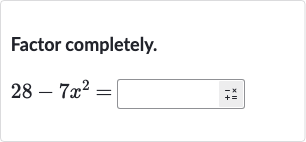AI tutor
Full solution
Q. Factor completely.
- Identify common factor: Identify the common factor in the terms and .Both terms have a common factor of .Factor out the :
- Factor out the common factor: Recognize the expression as a difference of squares. can be written as and is already a perfect square.So, can be expressed as
- Recognize difference of squares: Apply the difference of squares formula to factor .The difference of squares formula is .Using this formula, we get .
- Apply difference of squares formula: Combine the factored form of with the common factor we factored out in Step .The complete factored form is .

